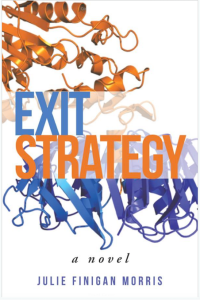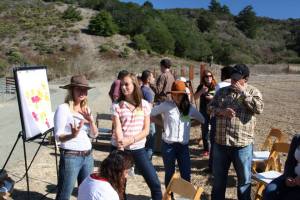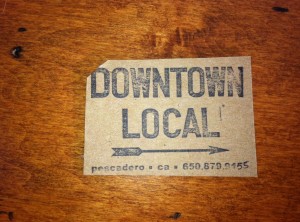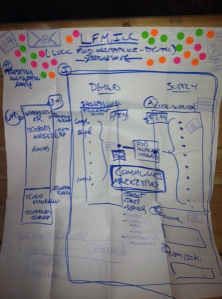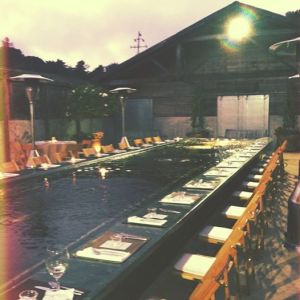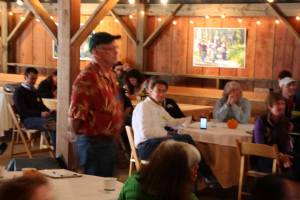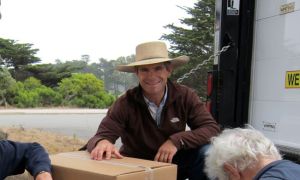Exit Strategy
April 7, 2017
“A crisis is a terrible thing to waste.”
~ Economist Paul Romer
I started working at a large produce company in April, 2005. My job was to assist the CEO with presentations, government relations and internal communications. I loved it. I advocated for healthy food policy on the national level, met interesting people in the organic agriculture world, and learned how our food is processed from farm to table. That all changed on September 14, 2006 when we found ourselves at the center of one of the largest foodborne illness outbreaks ever. E.coli-contaminated spinach, packed at one of our facilities in San Juan Bautista, California, had sickened hundreds of people across the country and killed three. Literally overnight, my job went from communicating the benefits of eating organic salads to helping coordinate a federal investigation between growers, scientists, investigators, lawyers, insurance agents and victims. For the next four years, I waded through lawsuits and assisted with the attempted sale of the company three times. The third time, the deal actually went through. The family-owned company that celebrated high morale, profit-sharing and innovation was unrecognizable by the time I left in 2010.
Exit Strategy is my first novel and is based on the E.coli crisis of 2006. It is a fictional account, but the themes could be taken from today’s headlines: income inequality, sexual harassment in the workplace, and immigration issues all circulate as a company struggles with its identity and future. Available in both print and eBook, I hope you will support me by buying a copy for yourself, a friend or family member, donate a copy to a local library and/ or request your local bookstore to carry it.
Below, I have listed five easy ways you can help me spread the word about Exit Strategy. (Shout out to Pieces of Me Author Lisbeth Meredith for these tips.) If you’ve already done any, or all, of these, I can’t thank you enough. If you haven’t had the opportunity yet, I would be so grateful if you’re inclined to support me. Thank you!
How you can help support Exit Strategy:
1. SOCIAL MEDIA: LIKE my page on Facebook (https://www.facebook.com/juliefiniganmorris), follow me on Instagram (@finimo), and share news about the book via social media (tag me when you do, so I can thank you, and please be patient while I catch up with thank you’s!) Also, feel free to join the conversation by using the hashtag #exitstrategy when posting.
2. BUY THE BOOK: Please consider buying the book! The first few months it’s on sale are VERY important for a new book release. You can order it through your local bookstore, direct from my publisher Author House, at Barnes and Noble (online or in person), and through Amazon. All of these links can be found on my website: http://juliefmorris.com
3. REVIEW: After you’ve read the book, post a review/rating of the book on Amazon. Reviews will help potential readers decide whether or not to buy the book, and the more reviews, the better.
4. GOODREADS: Add Exit Strategy: A Novel to your shelf on Goodreads and rate it honestly.
5. FOLLOW ME FOR INFO ON READINGS & EVENTS, OR SET AN EVENT UP YOURSELF: Join me at one of my upcoming events, and keep an eye on my website for more updates at http://juliefmorris.com Also feel free to schedule your own event, I would be honored to speak or do a book signing for your group. You can contact me via my website at https://juliefmorris.com/contact/ From civic groups to fundraisers, book groups, faith communities, the possibilities to connect in person or via Skype are endless.
Whatever you decide to do, how big or small, it helps and it means so much. Thank you for your continued support and encouragement, and please let me know how I can pay it forward.
Thank you so much,

Julie Finigan Morris
Mixing it up at TomKat Ranch
October 21, 2014
What do you get when you mix together innovators, entrepreneurs, farmers & ranchers? Great ideas that are already helping to change the landscape of local food production and consumption in California.
The Pescadero Idea Hack, held in Pescadero, Calif. on October 11, 2014, was the brainchild of The Mixing Bowl Hub’s Rob Trice and his wife, TomKat Ranch Executive Director Wendy Millet. Millet and her amazing team at the TomKat Ranch are our partners in the push to make grassfed beef the new normal. Like Morris Grassfed, TomKat Ranch is committed to considering the land, animals and people when producing its LeftCoast Grassfed beef and has worked hard to increase local, grassfed beef consumption in schools and restaurants in San Mateo County.
We started the day with introductions and it was humbling to be a in a room (a barn, actually) with so many people dedicated to producing good food and creating local markets that encourage and reward the work of farmers and ranchers.
“Our objective is to build upon numerous assessments and dialogues on the topic of the Peninsula’s local food production, and develop a range of actionable solutions. A byproduct of the Idea Hack is to connect individuals and organizations that could potentially collaborate to bring about desired changes,” Trice said in his opening remarks.
Participants like Karen Liebowitz, co-founder of the soon-to-open The Perennial restaurant in San Francisco and Pete Hartigan, Founder & CEO of Trusted Ventures, LLC are not only innovative thinkers, but agents for social change. Liebowitz’s new restaurant will source foods from local farms and ranches that go way beyond industrial, monocrop organics; they actively address climate change with their farming practices.
“We first started thinking about what can we do to engage with our environment more closely — not just farm to table, but really deeply engage,” Liebowitz said in a recent interview with the San Francisco Chronicle. The Perennial will be a “laboratory,” in which all aspects of the restaurant’s business — relationships with farmers, sustainable practices, choice of vendors — are seen through the lens of environmental impact, the article said.
Hartigan has put his money where his heart is. The founder of several successful start-ups, his latest is Trusted Ventures, LLC which aims to develop what he calls the “Impact 500” targeting existing Fortune 500 cash flows in areas like finance, healthcare and education, with a model where helping the community is how the company competes versus the traditional maximize shareholder profit model. If this sounds familiar, it’s because Hartigan has already created successful companies using the model, including the alumni-funded college loan business sofi.com, which he plans to take public this Spring. He’s not wasting any time on his next project ether. Our breakout group’s challenge: How Can We Increase the Amount of Local Food Consumed by Local Institutions?
After an hour-long discussion with institutional food buyers (Stanford and Google), distributors, farmers and ranchers we developed the “LOCAL FOOD MARKETPLACE, INC.” (LFM). Our idea is to develop a collaborative, digital market maker, facilitator/coordinator. LFM can create a demand book for local institutions looking to buy local food supply and aggregate local supply. To pay the premium for fairly priced local goods, dining services organizations can supplement their budget through HR budgets (since employee good food eating should result in lower health costs) or a company’s community social responsibility funding. Financial institutions with a social mission can finance working capital for growers. Participating growers can have an ownership stake in LFM’s success. (We won First Place, by the way.) Bam.
Other challenges included: How to train and support the next generation of farmers and ranchers? How to scale local food production? and How to deepen the connection between SF Peninsula eaters and growers? We took a hike on the spectacular TomKat ranch after our breakout sessions and capped the day with a candlelight dinner around the ranch’s coi pond table: a stunning setting and perfect way to celebrate the beauty and bounty of local food. The Mixing Bowl plans several follow-up sessions and has started discussion groups for each idea we came up with. The real success here is the awareness that good, local food is not only delicious, it’s a force for economic, social and ecological good.
A Shifting Landscape
April 8, 2014
There’s a messy food fight happening in kitchens across America. Like the disruptive innovators before them – Netflix, Uber and Square, to name a few – small farms and ranches are shaking the foundations of a powerful industry and sending shivers up the spines of their well-established, powerful competitors. Just five years ago, farmers’ markets and Community Supported Agriculture (CSA) were minor annoyances to the Food and Beverage Industry. But that’s changing rapidly. According to a recent report by the Harvard Food Law & Policy Clinic by 2008 “the value of local food sales in the United States reached $4.8 billion, up from $1.2 billion in 2007 and $551 million in 1997.”
Sessions at the Produce Marketing Association’s annual Fresh Summit Trade Show labeled local as a “trend” and patted us on the head with a smile. Common responses to the scrappy dog, pulling at the pant leg of marketing executives, were that local could never compete. They said, “The price point is too high,” “The quality not uniform enough for picky consumers,” and my personal favorite, “You can’t grow spring mix in Michigan in the winter.” What these companies didn’t see coming was the consistent cry from consumers wanting to know more about their food. People want to know who grew the tomato and how it was grown. They care more about the “Who and How” than they do about eating summer greens in January. I call it “First person certified.”
Joe and I started direct marketing grassfed beef to family and friends in 1992 after they dined at our home and asked, “Where can we buy this meat?” We worked with our local abattoir and butcher and within five years had developed a loyal following that came back year after year. They bought freezers to store a quarter cow and asked their mothers for Grandma’s Sunday roast recipe as they learned to use the whole cow. They brought their children to our Annual Field Day where Joe showed them how a border collie can gather a 100 cows and why perennial grasses and wildflowers can thrive where livestock have grazed. They liked that when they had a question, they could call us and we would pick up our own phone (or call them back if we weren’t in the office, which is often when you work in agriculture.) Twenty-two years later, we are still direct marketing and have a network of more than 900 members throughout California. When people from New York or Colorado call to ask if we ship, we direct them to a website that will help them find a local grassfed beef producer.
Innovation comes in many forms, often the result of an annoyed customer who says to herself: This should be easier! The old model is broken. Food based on cheap labor to grow and pack it, federally subsidized, imported water to grow it, plastic packaging to ship it, and $60-a-barrel oil to distribute it needs an alternative. Local networks are filling the space in innovative ways. Industrial, multinational food companies’ idea of a mobile strategy is making their websites fit on an iPhone screen. “New ideas” echo the 1950s: a coupon for participating in a survey or sweepstakes where you can win a shopping cart full of groceries, worth mere pennies to their bottom lines.
Meanwhile, local farmers are turning to a new model, one that makes it easier and more affordable to put good food on the table and actually adds value to consumers’ wallets and health. They’re using intuitive, interactive apps like Good Eggs, Whole Share and Farmigo that allow customers to add an extra dozen cage-free eggs to next Tuesday’s delivery. Working farm-centric communities, dubbed Agritopia, are replacing gated suburbs for nature and wildlife preserves as people realize the scarcity of water and opt for community gardens over golf courses. Marketing campaigns sponsored by local food advocacy groups such as Community Alliance with Family Farmers’ (CAFF) “Buy Fresh Buy Local” and the USDA’s “Know Your Farmer” raise awareness about the choices consumers have over their food purchases.
As people become more aware of their own decision-making power when it comes to food, the big guys are being asked about paying employees a living wage, challenged over inputs like pink slime and azodicarbonamide, aka the ‘yoga mat compound,’ or how many miles the spring mix traveled to Michigan.
Consumers want freshness. They also support organic, grassfed, local, no GMOs or antibiotics, and humane treatment of workers and animals. In the new model, you log on to your desktop or mobile device and order your favorite seasonal fruits, vegetables, meat and dairy to be delivered to your door (or picked up at a drop-off location) in a recycled cardboard box by your friend and neighbor. It’s either already paid for via your online account, or your delivery person swipes your credit card via Square and you’re on your way. The extra 50 cents per pound for meat employs your co-worker’s teenager, or better yet your own, who works for the local farm or butcher. That’s a win-win.

Packaged Food at Fred Meyer Store Source: http://www.flickr.com/photos/lyza/49545547
Ironically, the new model gets back to basics. All the labels that have emerged in the food industry can get exhausting. What ever happened to just going shopping? Does my chicken thigh really need to be certified by five organizations? The distance and anonymity of multi-national food companies has created another layer between people and their food, a whole new industry of third-party certification officers. If you don’t know who grows your food, you can outsource your relationship with the farmer to the USDA’s organic program or the American Humane Association’s animal welfare program who ensure that standards are being met. In the new model, your food is first person certified. If you want to know whether we feed our cattle grain or use sub-therapeutic antibiotics, you pick up the phone and call us. (We’ll tell you we don’t.) I answer texts and e-mails from our members every day. You can also come to our field day where we’ll show you the animals, the land and the people who produce your hamburger. The same goes for farmers who invite children to pick their own pumpkin at Halloween and strawberries in the summer.
The discussion among food industry leaders has gone from patting local producers on the head, to saying “there’s room for all of us'” to criticizing local as less efficient and unsustainable. Common battle cries are that “We have to feed the world.” and “Our food is cheaper!” But the innovators have shown there are farms and ranches all over the world that can feed their communities (recall pre-WW II?) and consumers don’t mind paying a bit more if it means their dollars strengthen the local economy. As industrial food marketers get more defensive, local food innovators are zooming past, coming up with even easier and cheaper solutions to getting their products on to kitchen tables, including adding a recipe for baked cauliflower in next week’s CSA box to replace that overpriced organic spring mix that’s been sitting in a truck for three days.
Food Forward
July 27, 2010
We had the pleasure last month of meeting Greg Roden and Stett Holbrook, two independent film makers working on a documentary about … food. I know, I know, maybe some of you are experiencing some “food fatigue” with all the recent books and documentaries about how our food is produced.
Indeed, people like Michael Pollan and Alice Waters have raised awareness about our food. Films like Food Inc., and Fast Food Nation have prompted the question: “What is this made of?” These are good questions though, and, larger than just ourselves. The food we eat affects more than our own health. Depending on how it is produced, food can be a hindrance (CAFOs, large monocrops, and pesticides flowing to the Gulf of Mexico) or help (healthy watersheds, carbon-sucking, healthy grasslands, abundant oceans) to our planet.
Greg and Stett are tackling a new angle on the food theme: looking at the people who produce it. They have moved beyond criticism of federal subsidies for corn and pollutants in industrial production (not that those are not still problems) to Solutions. Food Forward is a celebration of fishermen who catch sustainable fish, community gardens that feed inner-city neighborhoods and build community, and – full disclosure here: grassfed beef ranchers that manage for healthy rangelands and humane treatment of animals. Check out the trailer here: http://www.foodforward.tv/default.aspx
As a journalist, I was taught to write about all the sides of the story, offer an informed and balanced account to complex issues so readers can come to their own, educated conclusion. Food Forward does this by going beyond the problem of industrial food production and offering a way for everyone to participate in choices that are not only good for their bodies, but good for the planet. Here’s a note from Greg on how you can get involved. Hope to see you there!
Dear food lover,
A special night of food, wine and inspiration at San Francisco’s new Radius restaurant is just a week away and there’s still time to save your seat at the table. We, the co-creators of the Food Forward documentary TV series, are holding a one-of-a kind fundraising dinner Aug. 3. KQED has agreed to present our show to a national PBS audience upon successful completion of our pilot episode. We’d love to have your support to help us get there.
Chef Kelly Hughett is preparing a delicious menu of local foods that celebrate the flavors of late summer. The evening will also include wine pairings and gift bottles from premier local wineries that practice sustainable, organic or biodynamic winemaking including Burrell School Vineyards and Winery, Poetic Cellars, Sky Saddle Winery, Bonterra Vineyards, Robert Sinskey Vineyards, Thomas Fogarty Winery, and Loma Prieta Winery.
Attendees will also receive an organic cotton Food Forward grocery bag loaded with hand-selected, premium products from local purveyors including Swanton Berrry Farm, Katz and Company, Point Reyes Cheese Co., Route 1 Farms, Miette and other delicious products.
Check out yesterday’s great post on yesterday’s post on the excellent Grist.org!
What: Fundraising dinner for Food Forward pilot episode on urban agriculture.
When: 6 – 9 PM, Tuesday, August 3, 2010.
Where: Radius Restaurant, 1123 Folsom (btw. 7th & 8th), San Francisco.
Why: Let’s eat. Right. Now.
Cost: $250 / person.
In addition to a night of great food and wine, this dinner will include a screening of the new Food Forward trailer in HD. Guests will also have the opportunity to hear from some of the stars of our show and words of inspiration from environmental attorney Nicolette Hahn Niman, author of Righteous Porkchop and co-owner of BN Ranch in Bolinas, a farm she runs with husband and sustainable meat pioneer Bill Niman.
Can’t make the dinner? You can still contribute today by donating securely via Pal Pal.
Thanks for your support,
Stett and Greg
Food Forward co-creators
—
Greg Roden
510.926.7626
www.foodforward.tv
www.gregroden.com
New Year’s Resolutions
January 3, 2009
Just received my latest copy of Bon Appetit magazine, which I habitually put aside to read alone later with a glass of wine. This month’s (February 2009) special feature is “50 Easy Ways to Eat Green.” I was pleasantly surprised to see that No. 8 was “Buy a Side of Beef.”
Reporter Hugh Garvey sums it up better than any other I’ve seen in the past 17 years in this business:
“An increasing number of foodie carnivores are ordering grass-fed beef straight from the local farmers. Here’s why: The practice directly supports local farmers with a vested interest in taking care of the environment. Unlike grain and corn feed, grass requires no fossil fuel for transport. The regrowth of grazed grass removes carbon monoxide from the air.”
Garvey gets it. Grassfed beef is not only about good – and healthy – food; it’s about supporting your local rural community (family farms and ranches and all the businesses that go with them), economical food purchases, humane treatment of animals, and environmental stewardship. Eating the grassfed beef burger I had for dinner tonight (with a melted slice of Swiss cheese, served on a fresh Ciabatta role) will also accomplish the other benefits I mention. Why would people do anything else? To find a your local grassfed beef producer, go to www.eatwild.com and have a Happy New Year!
The Independence of Local Food
July 4, 2008
As we move through our delivery season we are fortunate to be the recipients of our customers’ many talents. In the world of food, there is a lot of sharing. On this Fourth of July, it is a fitting tribute to celebrate not only our country’s independence from Great Britian, but the independence that comes with sourcing your food from local producers, as our forefathers did. Because we are part of a growing coalition of local food makers, we are indeed indpendent from factors industrial food is linked to: high fuel costs (transporation) and high corn prices (processing), to name two.
Morris Grassfed Beef customers are foodies, and they know good, real food when they see it. Many of them make their own, gourmet items. Although food items are probably the most traded, we’ve been known to trade beef for piano lessons, artwork and even construction projects. Foodies are inherently talented people!
This week Joe brought home all sorts of goodies from our delivieries: a pound of Kenya Wango Estate Peaberry Barefoot Coffee, www.barefootcoffee.com, 8 oz. of Bravo Farms Handmade Cheese, Original Chipolte Cheddar, www.bravofarms.com, and a small bottle of 100% organic Avocadomolina extra virgin avocado oil.
I’m sipping a cup of the Kenya Wango coffee as a I write and it is – to quote their label – “a roller coaster of savory & syrupy flavors from sweet, V8 juice, cumin, and sweet snow peas.” Wow, definately a welcomed deviation from the vanilla latte at Starbucks!
Rhonda Gruber’s Bravo Farms Handmade Cheese is the most delicous cheddar I have ever tasted. I’ve been cutting a slice to enjoy with a glass of white wine each evening while I cook. I’ve also melted it into my favorite brown butter rice recipe to make a soupy risotto that’s out of this world. The flavor is smoked, but not dry. It has a chipolte kick that makes my taste buds dance.
We received a whole case of Good Earth teas from our friend and loyal customer Billy Healy. Our talented customer, Farrell, who loves to cook, gave us her own blend of Farrell’s Spicy Rub that makes a wonderful dry rub for beef, poultry or even just seasonings for grilled vegetables. Lucas Moen, who is doing deliveries for us now, brings us raw milk and cream in glass bottles from Claravale Farm in Watsonville, Calif. Not only is this as fresh as it gets, but it is thick, creamy and healthy. If you’ve never tasted the real thing, you should contact Lucas: lucamoen34@yahoo.com.
The beauty of all of these products is that they are made by hand, and with attention to detail. Each product is a tribute to the passion of its creator and a celebration of the indpendence of local food.
